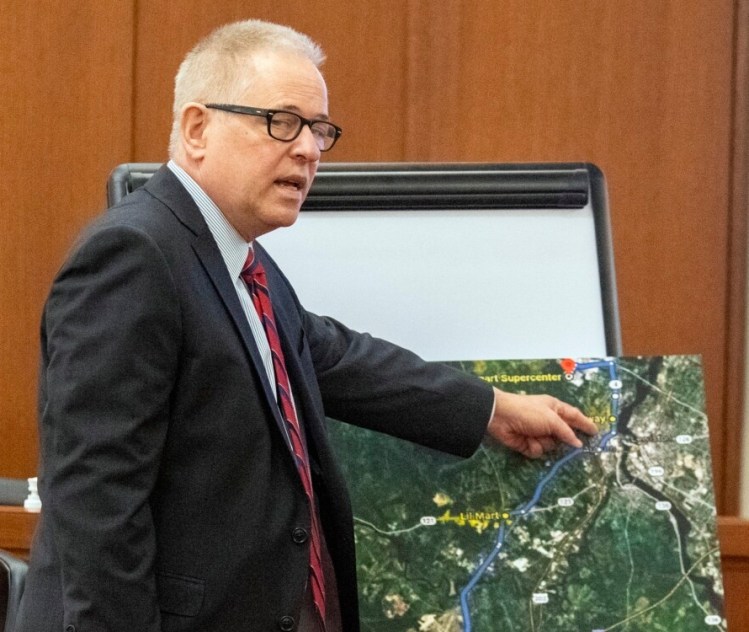AUGUSTA — As testimony wrapped up Tuesday in the murder trial of an Auburn man accused of shooting and killing a Turner man in the Auburn Walmart parking lot in 2019, attorneys for both sides focused on the location of the weapon when it was fired — a key point of contention in determining whether the shooting could have been in self-defense.
Closing arguments are expected Wednesday morning, with the case likely to go to the jury for deliberation and a verdict following those final words from attorneys, according to Superior Court Justice William Stokes.
Testimony Tuesday zeroed in on the location of the Glock 9 mm pistol that Gage Dalphonse, 23, of Auburn, used to shoot Jean Fournier, 41, of Turner, twice in the back the evening of July 27, 2019. Testimony also highlighted where Fournier was when Dalphonse pulled the trigger.
Defense attorneys and Dalphonse’s father, Daniel, sought throughout the trial to show Gage Dalphonse shot from inside his car, after Fournier confronted him and punched him once, and while Fournier was still at his driver’s side window.
On Monday, they showed a demonstration video and photographs made by Daniel Dalphonse in the months leading up to the trial, which they said showed Fournier must have still been at Gage Dalphonse’s driver’s side window. They cited the angle of the entry wounds in Fournier’s back, the presence of some gunshot residue inside the car’s rear driver’s side window, and the fact one of the two shell casings were found on the driver’s side floor mat inside the car.
In rebuttal testimony, however, Detective Sgt. Scott Bryant, evidence response team commander for the Maine State Police at the state crime laboratory, said the video made by Dalphonse’s dad, “tells me the gun was not fired inside the car.”
Bryant said where a bullet casing is ejected to is not a reliable indicator of where a gun was when it was fired because the path of the casings can vary due to numerous factors including ammunition type, how the gun was held, and the possibility the casing would bounce off other objects, as the casings did in the demonstration video, both of them hitting the steering wheel and bouncing off to the right.
Prosecution witnesses previously testified Gage Dalphonse shot Fournier while leaning out of his car window, as he was running away.
Video footage of the incident from Walmart security cameras shows Fournier running from beside Gage Dalphonse’s Volkswagen GTI hatchback, and getting two or three steps past the end of the car before he collapsed to the ground after being shot.
With Bryant on the stand, defense attorney James Howaniec raised the issue of state police apparently losing the bullet casing that had landed in the car. An officer on the scene noted and marked the location of the bullet casing inside the car, but left it there and the car was taken by flatbed truck to the state’s crime laboratory in Augusta, where forensics experts processed its contents. But they didn’t find the bullet casing, acknowledged Tuesday by Bryant and Kimberly James, senior laboratory scientist who supervises the firearms unit at the Maine State Crime Laboratory.
Instead, Daniel Dalphonse testified, he found the bullet casing in the footwell of the car after it was returned to the family by police about three weeks after the shooting, which he said was shocking.
James said she was aware a casing had been located in the vehicle, but said it was never submitted to the crime laboratory for processing. She said she’s since been made aware the casing was inside the car, but laboratory workers who processed the car while it was at the lab did not find it.
Bryant said he observed both the casing in the car and one found in the parking lot at the crime scene, but didn’t know what happened to it after the vehicle was taken to the crime lab. He said the casing and its location in the car were considered as part of his evaluation of what happened in the shooting, despite it going missing while in police custody.
Due to the coronavirus pandemic, everyone in the courtroom was required to wear masks. Stokes told witnesses that if they had been vaccinated they could remove their masks to testify on the witness stand, but allowed them to leave them on if they wished. He instructed witnesses testifying with their masks on to briefly pull their masks down so the jury could see their faces.
Comments are not available on this story.
Send questions/comments to the editors.



